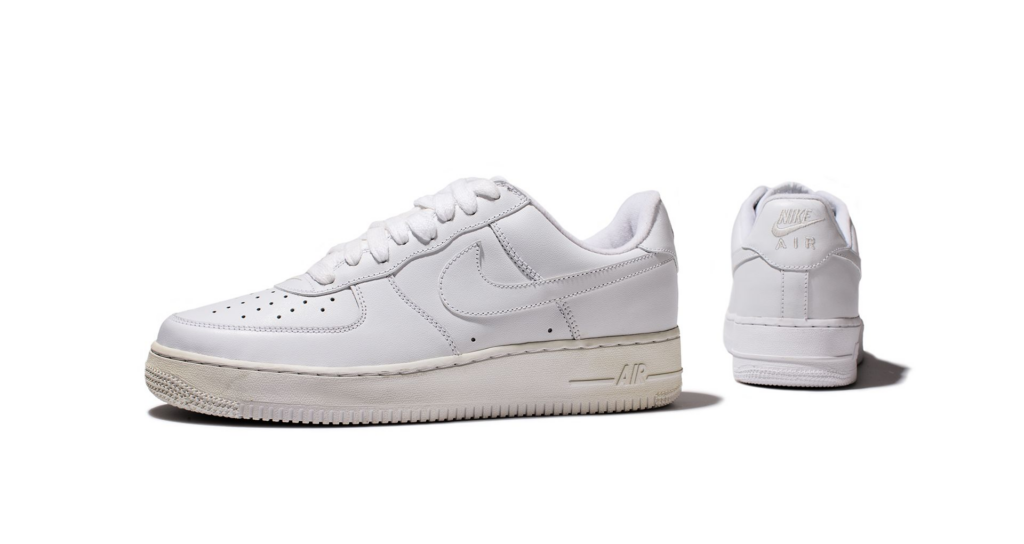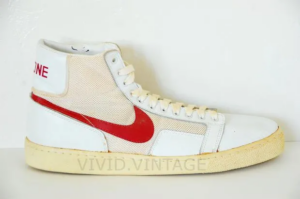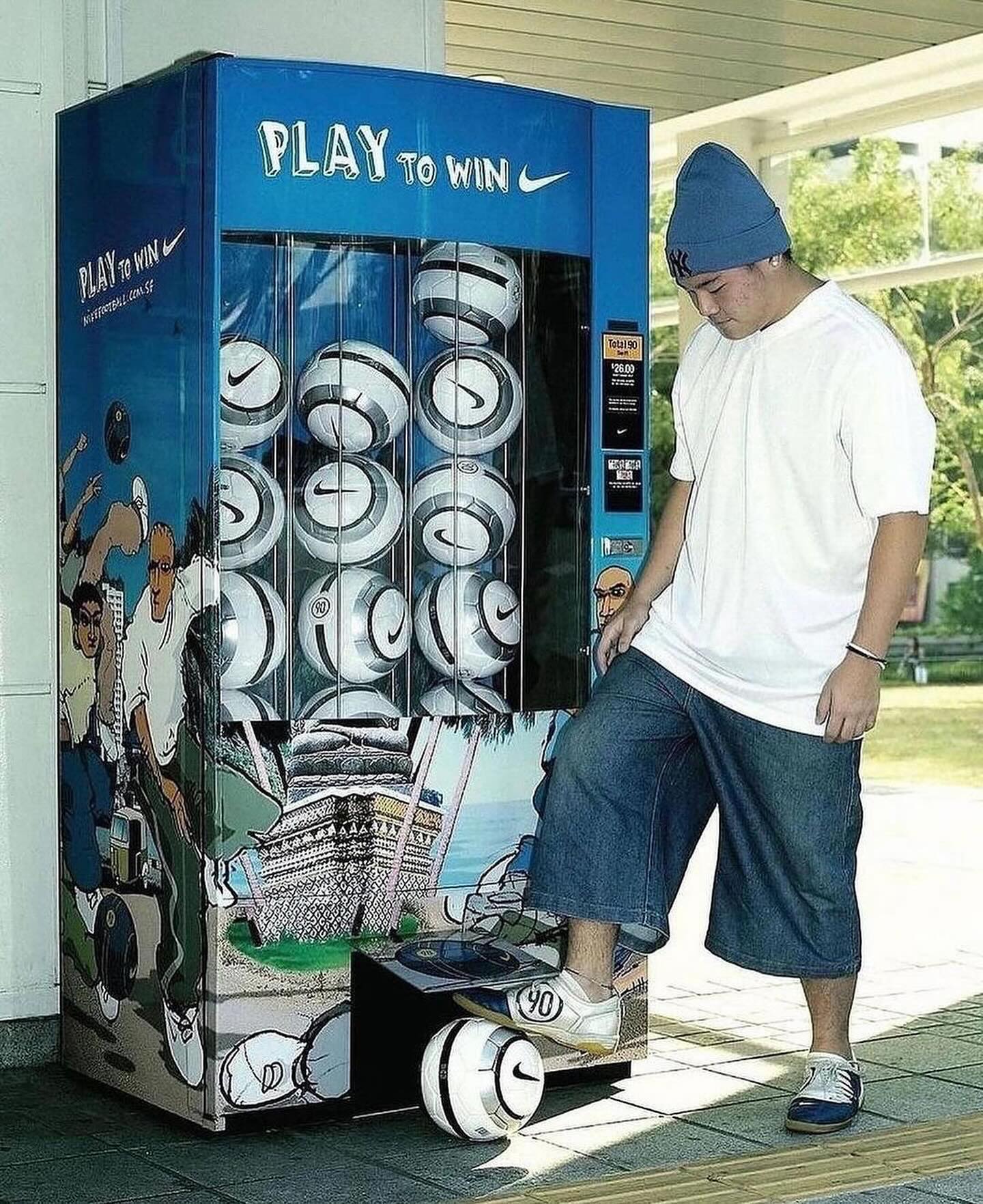In my journey to becoming a better marketer, I stumbled upon an incredible example of how a sports product can transcend its original purpose to become a cultural icon. As someone who loves sports, the entertainment industry, and fashion, I found the story of the Nike Air Force 1 High truly fascinating. If you’re not interested in reading the full post, here are the key takeaways that I found relevant to marketing and storytelling. First, create something new and place it on a winning stage. Nike’s innovative Air cushioning system and strategic marketing made the AF1 a standout success. Second, let the story unfold organically. The shoe’s success was cemented through moments like Moses Malone’s MVP-worthy performance in the 1983 NBA Finals, which solidified the AF1’s place in basketball history and gave it lasting cultural significance. These lessons are key to understanding what made the Air Force 1 a global icon and why it remains an exceptional example of powerful marketing today.
The Nike Air Force 1
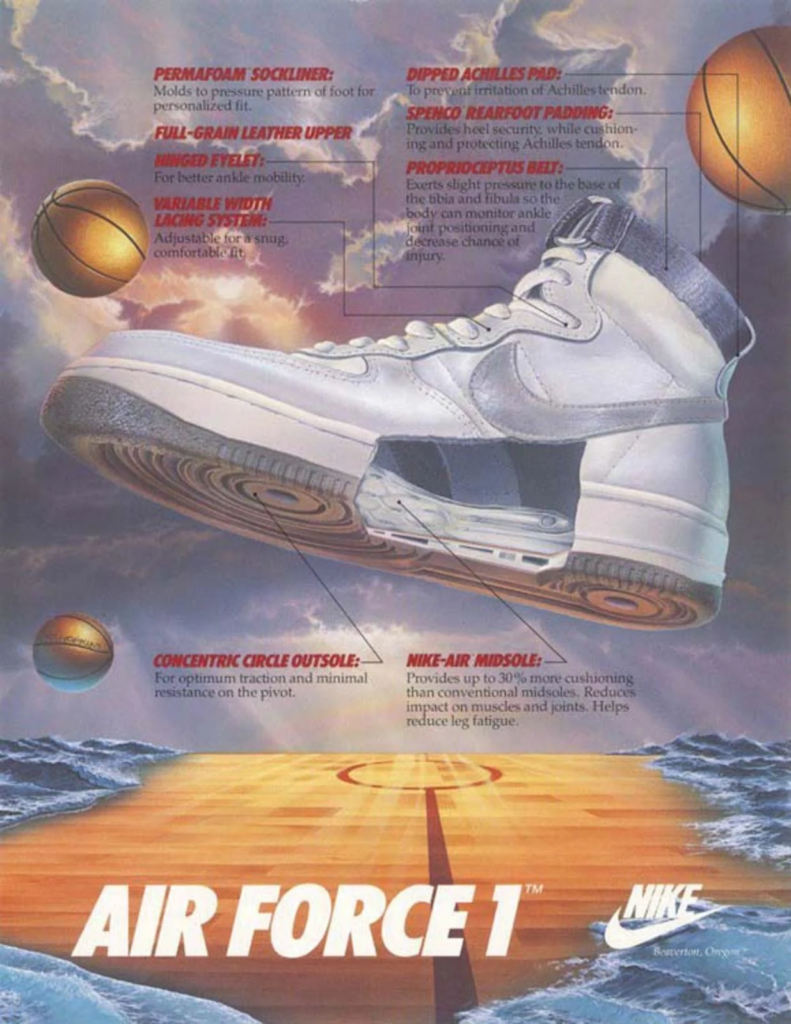
The Nike Air Force 1 High, released in 1982, marked a groundbreaking moment in basketball footwear history. It was the first-ever basketball shoe to feature Nike’s innovative Air cushioning system, revolutionizing the comfort and performance of basketball shoes. Designed by Bruce Kilgore, the Air Force 1 High was equipped with a thick inner sole that housed the Air technology, offering 30% better cushioning than previous models. This innovation was specifically tailored to support the needs of basketball athletes, ensuring they had a high-performance shoe that provided both stability and comfort on the court. When Nike launched the Air Force 1 (AF1) in 1982, its mission was straightforward: create the ultimate basketball shoe for on-court excellence. What Nike couldn’t have foreseen was how this performance-driven sneaker would evolve into a cultural icon, influencing music, fashion, and global streetwear. The AF1’s story is more than a tale of success—it’s a masterclass in marketing, authenticity, and brand evolution.
The design of the Air Force 1 was also ahead of its time. The high-top structure, featuring an adjustable Velcro collar, offered ankle support to protect players from injuries like sprained ankles. Nike also incorporated a concentric circle sole pattern, which provided superior traction, making quick and rotational movements smoother and more efficient. This design was developed through extensive research at the Nike Research Laboratory, proving the company’s commitment to crafting the perfect shoe for athletes.
The Nike Air Force 1 High, originally priced at $89.95 in 1982, it wasn’t just another basketball shoe—it was a carefully engineered tool built for the specific demands of the sport. Nike’s marketing emphasized the shoe’s performance features, showcasing its revolutionary Air technology and targeting athletes who needed high-performance footwear. The Air Force 1 wasn’t just designed to look good; it was built with the athlete in mind, positioning Nike as a brand dedicated to serving the needs of professional players.
Nike’s understanding of athletes’ needs and their commitment to innovation were key drivers in the success of the Air Force 1, and they set the foundation for the sneaker’s eventual rise as a cultural icon. This early focus on performance and quality, coupled with groundbreaking design, laid the groundwork for what would become one of the most influential sneakers in the world.


Before the AF1 was released, basketball shoes were about as basic as they come. Players were accustomed to wearing three, four, maybe even five pairs of socks to help soften the blow of landing on concrete. To create a more supportive shoe, Air Force 1 designer Bruce Kilgore took inspiration from a Nike hiking boot called the Approach. Because hiking involves strenuous up-and-down motions, the Approach had a lowered back heel, helping to alleviate pressure on the Achilles tendons. It made sense to Kilgore to apply some of that thinking for basketball players.
Upon the AF1’s release in late October 1982, Nike announced that the shoes cushioned shock 30 percent better and were 20 percent more resilient than a standard shoe. Once players took them to the court, they fell in love.
The Origins: Designed for the Court
The Air Force 1, designed by Bruce Kilgore, marked a pivotal moment in basketball footwear history. As the first basketball shoe to feature Nike’s revolutionary Air-Sole technology, it set new standards for cushioning and performance. With a durable leather upper and thick rubber outsole, the AF1 offered stability, traction, and comfort—qualities that quickly made it a favorite among NBA athletes.
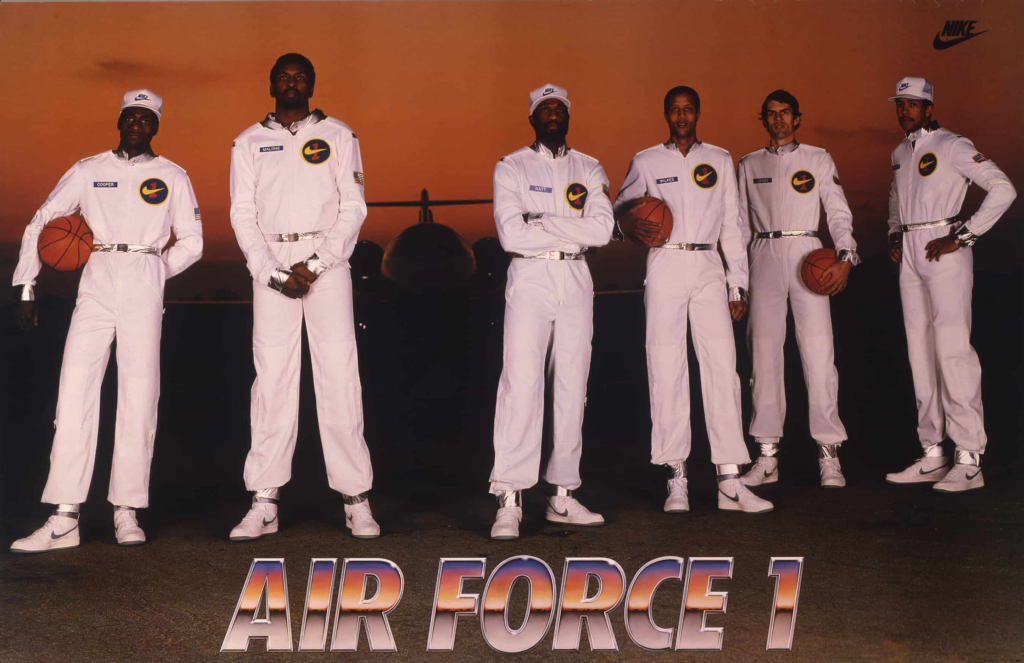
Nike’s marketing team understood the power of endorsement, launching the ‘Original Six’ campaign in 1982/83 to promote the AF1. They signed contracts with six standout NBA players to test the new white and silver AF1. The ‘Original Six’ included Moses Malone and Bobby Jones of the Philadelphia 76ers, Mychal Thompson and Calvin Natt of the Portland Trail Blazers, and Jamal Wilkes and Michael Cooper of the LA Lakers. Interestingly, Moses Malone, who wore the AF1, helped lead the 76ers to an NBA championship, a significant factor in the sneaker’s rise in popularity in Philadelphia.
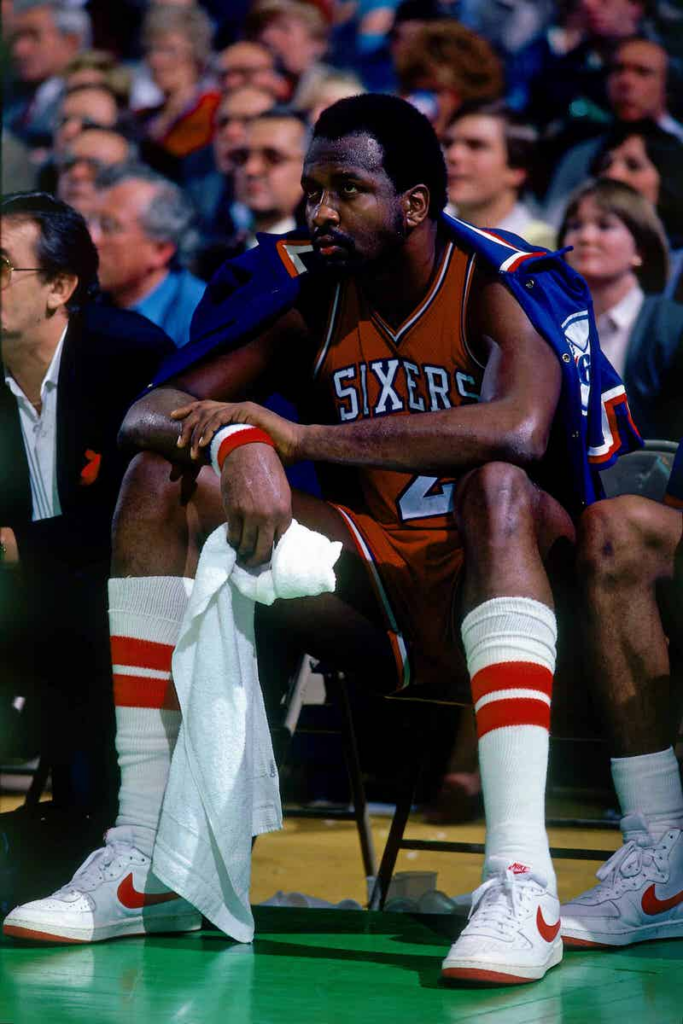
Moses Malone’s extraordinary playoff run during the 1983 NBA Finals was pivotal in cementing the Nike Air Force 1’s association with winning and excellence. Known for his bold prediction of “fo’, fi’, fo’” (a shorthand for sweeping through the playoffs in four games per series), Malone led the Philadelphia 76ers to one of the most dominant postseason performances in NBA history. While they ultimately fell one game short of his prediction, going “fo’, fi’, fo’” with a record of 12-1, their dominance was unparalleled.
During the Finals against the Los Angeles Lakers, Malone was unstoppable. In Game 4, he delivered a monumental performance with 24 points and 23 rebounds, showcasing his ability to control the paint on both ends of the court. Over the course of the series, Malone averaged 25.8 points and 18 rebounds per game, an astounding display of dominance that earned him the Finals MVP award.

Nike leveraged Malone’s heroics as a testament to the Air Force 1’s performance on the court. Former Nike CMO Greg Hoffman remarked, “The Air Force 1 wasn’t created to make a statement in culture; it was created to make a statement on the court. And the fact that Moses Malone won on the court in the Air Force 1—that’s cool.” Malone’s association with the AF1 became a cornerstone of its legacy, bridging the gap between high-performance athletic footwear and cultural relevance.
From Hardwood to Streetwear Icon
The AF1’s transition from basketball essential to streetwear staple was fueled by its clean, versatile design and durability. By the late 1980s, urban communities and hip-hop culture had embraced the sneaker. Artists like Rob Base and DJ E-Z Rock were spotted wearing AF1s in music videos, and the shoe’s popularity skyrocketed.
However, it was Nelly’s 2002 hit single Air Force Ones that cemented the sneaker’s cultural dominance. Featured on his Nellyville album and accompanied by St. Lunatics rappers Kyjuan, Ali, and Murphy Lee, the song celebrated the AF1 as more than just a shoe—it was a status symbol, a representation of individual style and authenticity. The track peaked at number 3 on the Billboard Hot 100 and was the third top 5 hit from Nellyville.
Nelly himself has claimed credit for the rise in popularity—and price—of the AF1. In a 2022 interview with Complex, he reflected, “When we first started rocking Air Force Ones, they were $59.99. We did the song. Eight months later, they were $100 […] and we ain’t get no residuals.”
He added, “Everybody that got Nike shoe deals need to be thanking us right now. We opened Nike’s eyes to a lot of that. At that time, they weren’t doing it. They were basically on some ‘they’re gon’ win regardless.’”
For decades, Nelly and the Air Force 1 were synonymous, with the rapper even securing Nike as a name sponsor for his Nellyville Tour. While Nike’s marketing power propelled the sneaker to global success, there’s no denying that Nelly’s influence introduced the AF1 to new audiences, solidifying its place in pop culture.
The Air Force 1: A Symbol of Wealth and Style
The Nike Air Force 1 High, originally priced at $89.95 in 1982, would be equivalent to approximately $253.75 in today’s market value. When the Air Force 1 debuted, it wasn’t merely a new basketball shoe—it was a groundbreaking product designed to meet the demands of athletes. With Nike’s innovative Air cushioning system, the shoe promised enhanced comfort and performance on the court. Nike’s marketing strategy highlighted the advanced features of the AF1, emphasizing its Air technology and positioning it as the ultimate footwear for athletes seeking superior performance. The Air Force 1 was more than just a stylish option; it was engineered with precision to support and elevate athletes’ performance, solidifying Nike’s reputation as a brand focused on delivering the best for professional players.
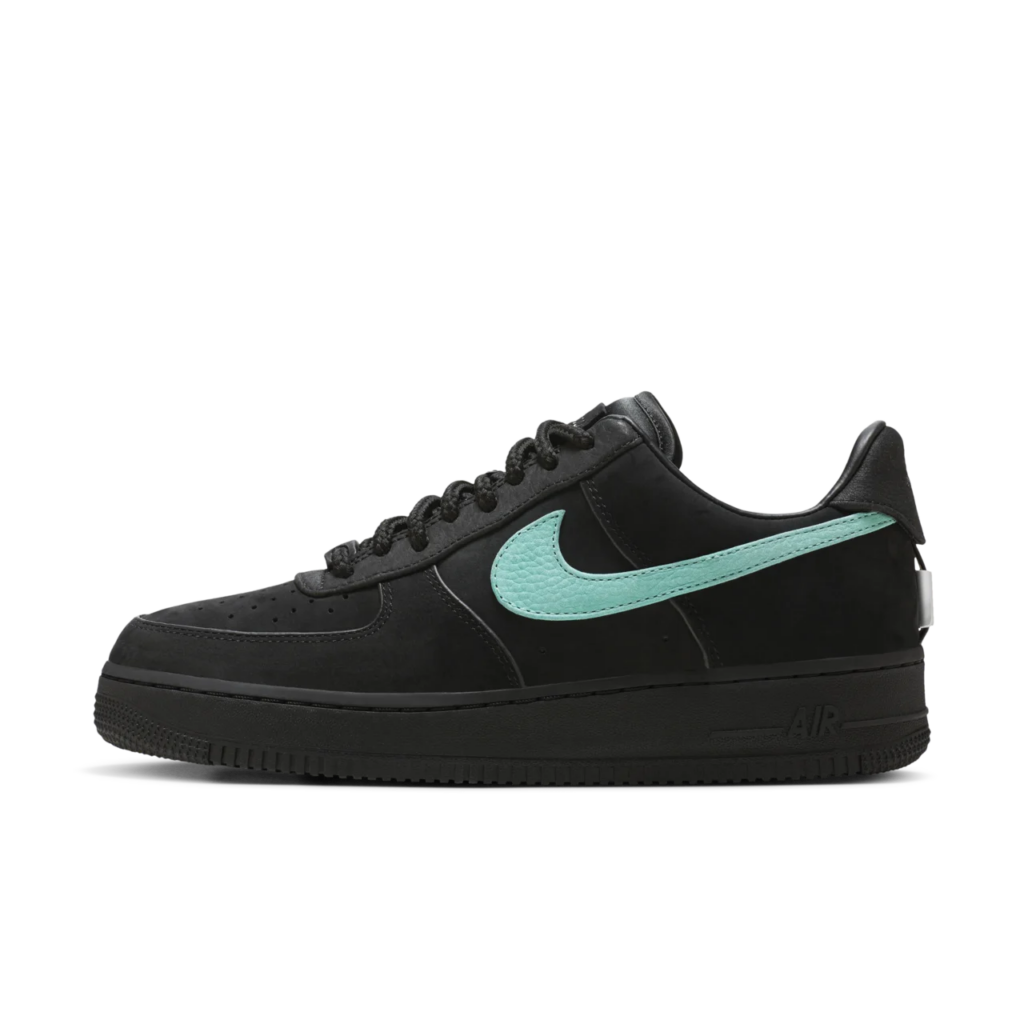
But that $89.95 price tag in 1982 was more than just a reflection of the shoe’s cutting-edge technology and comfort. In a way, Nike was unknowingly selling prestige. The high price point helped position the Air Force 1 as a premium product, creating an air of exclusivity. The combination of innovation, limited availability, and association with top athletes transformed the Air Force 1 into more than just a high-performance basketball shoe—it became a symbol of success, status, and wealth. The shoe was no longer just a stylish accessory; it became a mark of financial achievement. This perception elevated the Air Force 1 beyond the basketball court, making it a must-have item not only for athletes but also for those seeking to flaunt their social standing. This move laid the foundation for the Air Force 1’s rise as a cultural icon, making it not only a go-to choice for athletes but also a coveted fashion item across various communities.
Nike’s Secret to Success: Staying True to the AF1’s Roots
What makes the AF1 so iconic is that, despite its evolution into a streetwear and fashion staple, Nike never strayed from the shoe’s original design. The AF1’s timeless elements—its durable leather, classic silhouette, and performance features—have remained unchanged, even as collaborations with artists like Travis Scott and special-edition releases have added new layers of cultural relevance.
Nike didn’t chase trends with the AF1. Instead, it embraced the shoe’s authenticity, letting the culture adopt it. This is the key takeaway for brands looking to make a lasting impact: true “coolness” is earned, not manufactured. Nike’s approach teaches us that when a product excels at its core purpose, it doesn’t need to chase trends; it will naturally resonate with consumers over time.
The Marketing Takeaways: Authenticity and Timeless Appeal
The story of the Air Force 1 offers important marketing lessons:
- Prioritize Functionality: The AF1 became iconic because it was built for a specific purpose—performance on the basketball court. Brands should focus on designing products that excel in their core function, as quality and performance resonate deeply with consumers.
- Let Culture Embrace You: Nike didn’t force the AF1 into pop culture—it allowed the culture to adopt it. Brands should embrace authenticity and let their products find a place in the cultural conversation on their own terms.
- Timeless Design is King: Trends come and go, but timeless designs endure. The AF1’s simple, durable design has allowed it to evolve without losing its essence, making it adaptable to various markets and trends.
- Collaborate, Don’t Pander: Nike’s collaborations have added new layers of cultural relevance to the AF1. But these partnerships build on the shoe’s legacy, rather than radically changing its identity. Authentic collaborations enhance a product’s relevance without compromising its core identity.

Defining Cool in Marketing
Coolness isn’t about being flashy or trendy—it’s about staying true to your values, offering something of genuine quality, and being relevant in the long run. The Air Force 1 didn’t become iconic because it tried to be cool—it became legendary because it was exceptional at what it was designed to do.
Nike’s approach to the AF1 shows that if you build a product that performs, resonates authentically, and doesn’t chase fleeting trends, you can create something that transcends time and becomes a part of culture. The AF1 is proof that true coolness is earned, not bought.
Conclusion
Nike’s Air Force 1 is a masterclass in marketing. It proves that authenticity, functionality, and timeless design are the building blocks of a lasting cultural legacy. As other brands look to create their own icons, they would do well to remember the lessons of the AF1: Stay true to your purpose, let culture come to you, and never sacrifice authenticity for trends.
What lessons do you think other brands can learn from the evolution of the Air Force 1? Let us know in the comments!
